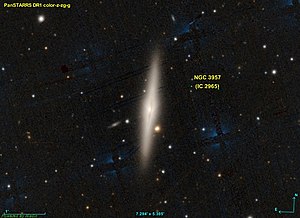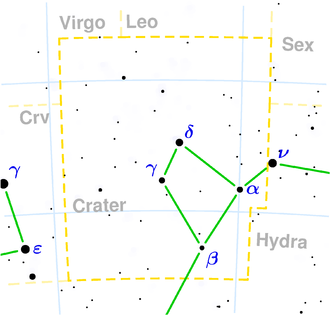NGC 3957
| Galaxy NGC 3957 / IC 2965 |
|
|---|---|

|
|
| AladinLite | |
| Constellation | cups |
|
Position equinox : J2000.0 , epoch : J2000.0 |
|
| Right ascension | 11 h 54 m 01.5 s |
| declination | -19 ° 34 ′ 08 ″ |
| Appearance | |
| Morphological type | SA0 + : |
| Brightness (visual) | 12.1 mag |
| Brightness (B-band) | 13.0 likes |
| Angular expansion | 2.9 ′ × 0.7 ′ |
| Position angle | 173 ° |
| Surface brightness | 12.8 mag / arcmin² |
| Physical data | |
| Affiliation |
NGC 4038 group LGG 263 |
| Redshift | 0.005460 +/- 0.000063 |
| Radial velocity | 1637 +/- 19 km / s |
|
Stroke distance v rad / H 0 |
(66 ± 5) x 10 6 ly (20.2 ± 1.4) Mpc |
| history | |
| discovery | William Herschel |
| Discovery date | February 7, 1785 |
| Catalog names | |
| NGC 3957 • IC 2965 • PGC 37326 • ESO 572-014 • MCG -03-30-017 • IRAS 11515-1917 • 2MASX J11540154-1934073 • SGC 115128-1917.4 • GC 2611 • H II 294 • LDCE 856 NED003 | |
NGC 3957 = IC 2965 is a lenticular galaxy of the Hubble type S0 / a in the constellation Crater south of the celestial equator . It is an estimated 66 million light years from the Milky Way , about 60,000 ly in diameter, and is part of the NGC 4038 group .
In the same area of the sky are u. a. the galaxies NGC 3956 , NGC 3969 , NGC 3472 , NGC 3981 .
The object was discovered on February 7, 1785 by the German-British astronomer Wilhelm Herschel .
